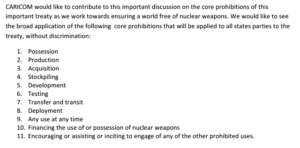The first round of negotiations has just concluded and before we know it, the second round will be upon us! Before the first round of negotiations, I published a series of countdown blogs. It seems, with less than ten weeks until the next round of negotiations, a good thing to do again. First, let’s take a look at how things turned out in the first round, compared to the hopes outlined in the (first) countdown series.
Overall, it was clear that the overwhelming majority of states are negotiating the same treaty. That wasn’t a given, and there were a few standouts. For the most part, each of the countries came to the table with a clear idea of what they want to see in the treaty. And for many, that list was strikingly similar. CARICOM’s presentation was one of the most striking, with the representative from Antigua and Barbuda delivering an actual list of 11 core prohibitions they’d like to see in the treaty.
Anytime there are areas of convergence there are also areas of divergence. I’ll use this next blog series to chip in some thoughts about those as well. However, overall it is clear that all those who came ready to negotiate did so in preparation for a solid prohibition treaty text.
I also want to take a moment and give credit to Ambassador Elayne White of Costa Rica- it’s not an easy position. I’d thought that it would take two or three days, optimistically, to get final agreement on the rules of procedure for the negotiations, but Ambassador White got it done well. She also preserved the space for civil society, and made sure that the voices of civil society were heard in the negotiations. Having spent years watching men deliver the International Women’s Day statement to the CD, the only NGO intervention allowed, it was a welcome change. Direct dialogue with civil society engage is also a positive reflection of the partnership model for effective change- bringing civil society, international organisations, and the governments together to advance discussions on the most difficult of issues.
Of course after any time of intensive activity its always good to take a moment to pause and reflect. Looking back at the series of blog posts published in advance of the first round, it’s useful to see how the issues fared.
Notably, the countdown series referred to how certain elements of the treaty might relate to states with nuclear weapons in their security strategies. With the exception of the Netherlands, those states didn’t bother to show up. To be honest, I was surprised. For example, how can a country like Germany, that stated so clearly at the 2015 NPT Review Conference “the pace of implementation of the Action Plan is too slow. Let’s force the pace, ladies and gentlemen” not attend the first significant multilateral negotiation on nuclear weapons in a generation?
One would think that countries that claim reliance on international agreements to use a weapon might make an appearance at any international discussion about those weapons. Then again, as Irish Ambassador Patricia O’Brien stated in the opening segment “We know that change only comes about when the status quo becomes less comfortable, when the discomfort of doing something new becomes less than keeping things the same.”
Its enough to make you think that the real reliance for these countries is an unchanging global system of have and have not, much more than a weapon designed to kill indiscriminately. The defenders of the status quo are scared that this treaty negotiation, a reflection of a world order that has changed significantly since they came together in their little groupings, will force the democratic reckoning that has been hovering on the horizon since the last nuclear weapon related negotiations. It will.
Looking ahead to the next round, scheduled to begin on 15 June, it is time to solidify the areas of convergence. For the most part, the first round showed that nearly all states want to comprehensively prohibit activities related to making, getting, having and using nuclear weapons. The areas of difference are in the detail, and rightly so- without any differences it wouldn’t be much of a negotiation. Exciting times lie ahead, the pace is quickening and we’re closer than ever to finally banning the bomb.

